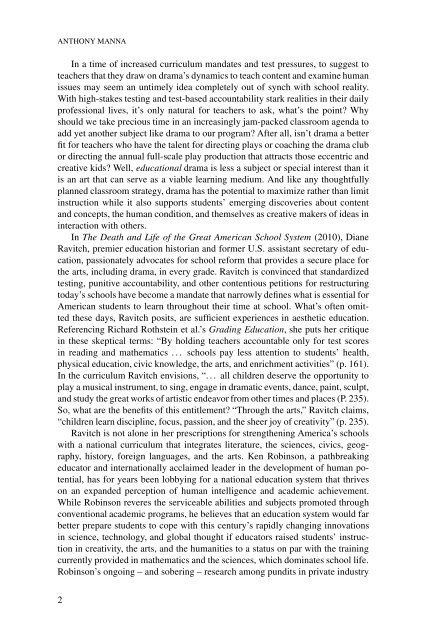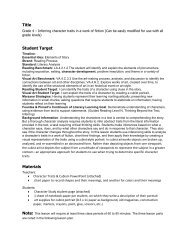1017-teaching-drama-in-the-classroom
1017-teaching-drama-in-the-classroom
1017-teaching-drama-in-the-classroom
Create successful ePaper yourself
Turn your PDF publications into a flip-book with our unique Google optimized e-Paper software.
ANTHONY MANNAIn a time of <strong>in</strong>creased curriculum mandates and test pressures, to suggest toteachers that <strong>the</strong>y draw on <strong>drama</strong>’s dynamics to teach content and exam<strong>in</strong>e humanissues may seem an untimely idea completely out of synch with school reality.With high-stakes test<strong>in</strong>g and test-based accountability stark realities <strong>in</strong> <strong>the</strong>ir dailyprofessional lives, it’s only natural for teachers to ask, what’s <strong>the</strong> po<strong>in</strong>t? Whyshould we take precious time <strong>in</strong> an <strong>in</strong>creas<strong>in</strong>gly jam-packed <strong>classroom</strong> agenda toadd yet ano<strong>the</strong>r subject like <strong>drama</strong> to our program? After all, isn’t <strong>drama</strong> a betterfit for teachers who have <strong>the</strong> talent for direct<strong>in</strong>g plays or coach<strong>in</strong>g <strong>the</strong> <strong>drama</strong> clubor direct<strong>in</strong>g <strong>the</strong> annual full-scale play production that attracts those eccentric andcreative kids? Well, educational <strong>drama</strong> is less a subject or special <strong>in</strong>terest than itis an art that can serve as a viable learn<strong>in</strong>g medium. And like any thoughtfullyplanned <strong>classroom</strong> strategy, <strong>drama</strong> has <strong>the</strong> potential to maximize ra<strong>the</strong>r than limit<strong>in</strong>struction while it also supports students’ emerg<strong>in</strong>g discoveries about contentand concepts, <strong>the</strong> human condition, and <strong>the</strong>mselves as creative makers of ideas <strong>in</strong><strong>in</strong>teraction with o<strong>the</strong>rs.In The Death and Life of <strong>the</strong> Great American School System (2010), DianeRavitch, premier education historian and former U.S. assistant secretary of education,passionately advocates for school reform that provides a secure place for<strong>the</strong> arts, <strong>in</strong>clud<strong>in</strong>g <strong>drama</strong>, <strong>in</strong> every grade. Ravitch is conv<strong>in</strong>ced that standardizedtest<strong>in</strong>g, punitive accountability, and o<strong>the</strong>r contentious petitions for restructur<strong>in</strong>gtoday’s schools have become a mandate that narrowly def<strong>in</strong>es what is essential forAmerican students to learn throughout <strong>the</strong>ir time at school. What’s often omitted<strong>the</strong>se days, Ravitch posits, are sufficient experiences <strong>in</strong> aes<strong>the</strong>tic education.Referenc<strong>in</strong>g Richard Rothste<strong>in</strong> et al.’s Grad<strong>in</strong>g Education, she puts her critique<strong>in</strong> <strong>the</strong>se skeptical terms: “By hold<strong>in</strong>g teachers accountable only for test scores<strong>in</strong> read<strong>in</strong>g and ma<strong>the</strong>matics . . . schools pay less attention to students’ health,physical education, civic knowledge, <strong>the</strong> arts, and enrichment activities” (p. 161).In <strong>the</strong> curriculum Ravitch envisions, “. . . all children deserve <strong>the</strong> opportunity toplay a musical <strong>in</strong>strument, to s<strong>in</strong>g, engage <strong>in</strong> <strong>drama</strong>tic events, dance, pa<strong>in</strong>t, sculpt,and study <strong>the</strong> great works of artistic endeavor from o<strong>the</strong>r times and places (P. 235).So, what are <strong>the</strong> benefits of this entitlement? “Through <strong>the</strong> arts,” Ravitch claims,“children learn discipl<strong>in</strong>e, focus, passion, and <strong>the</strong> sheer joy of creativity” (p. 235).Ravitch is not alone <strong>in</strong> her prescriptions for streng<strong>the</strong>n<strong>in</strong>g America’s schoolswith a national curriculum that <strong>in</strong>tegrates literature, <strong>the</strong> sciences, civics, geography,history, foreign languages, and <strong>the</strong> arts. Ken Rob<strong>in</strong>son, a pathbreak<strong>in</strong>geducator and <strong>in</strong>ternationally acclaimed leader <strong>in</strong> <strong>the</strong> development of human potential,has for years been lobby<strong>in</strong>g for a national education system that thriveson an expanded perception of human <strong>in</strong>telligence and academic achievement.While Rob<strong>in</strong>son reveres <strong>the</strong> serviceable abilities and subjects promoted throughconventional academic programs, he believes that an education system would farbetter prepare students to cope with this century’s rapidly chang<strong>in</strong>g <strong>in</strong>novations<strong>in</strong> science, technology, and global thought if educators raised students’ <strong>in</strong>struction<strong>in</strong> creativity, <strong>the</strong> arts, and <strong>the</strong> humanities to a status on par with <strong>the</strong> tra<strong>in</strong><strong>in</strong>gcurrently provided <strong>in</strong> ma<strong>the</strong>matics and <strong>the</strong> sciences, which dom<strong>in</strong>ates school life.Rob<strong>in</strong>son’s ongo<strong>in</strong>g – and sober<strong>in</strong>g – research among pundits <strong>in</strong> private <strong>in</strong>dustry2



